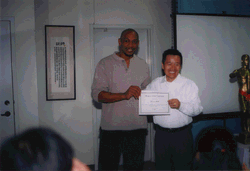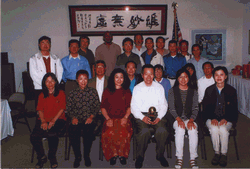




|
FREMONT TANG SOO DO NEWSLETTER Winter 2001 Coming Full CircleI was introduced to an Asian origin style of martial arts in the late 1970’s; the Korean Art of Tang Soo Do. Just the name “Tang Soo Do” reflects a strong influence and shared cultural background between China and Korea; with “Tang” from the T’ang Dynasty of China and “Soo” a Korean word that means hand, “Do” means way of life or simply the way. I have found over the past twenty years, Tang Soo Do to be one among the finest and most complete fighting systems in the world today. Little did I know in the 70’s that Tang Soo Do would bring me to begin to understand one of the most powerful treasures of the Chinese culture; CHI KUNG. From the beginning, the very basic stances were described to me with a strong sense of balance. The spine was to remain erect, even when moving; the head was to be held as if suspended from a string. The thought of the body’s energy (Chi) was stored in the abdomen ( Dan Tien) manifested itself throughout my training. Relaxed clear awareness of the abdomen, the energy could be activated; when the base of the spine was erect, it would rise to the top of the head. Corrective breathing has also been a part of my training from the beginning. The simple thought of a deep breath in through the nose with the mouth closed, dropped to the abdomen; then out of the mouth controlling the air with the Esophagus, would relax the body and all of it’s organs including the brain. In the fighting arts relaxed muscles will allow the body to move quickly and smooth. A relaxed brain will allow for swift thoughts, good for change when defense or offense is necessary. Regulating the breathing with movement; inhaling in the step and exhaling at the end of the step, was also strongly suggested. The thousands of blocks and punches
have also proven to be very important in this circle. Training to
punch with a sense of body balance; pushing one hand to attack while
retracting the other with the same force, rotating them both at
the same time and place, makes for a sense of positive and negative
affect. Blocking one down and one up makes for the same negative
and positive affect, again rotating them at the same time and place.
The mind has also been carefully tuned. The martial artist has to be conscious of his surroundings at all times. When fighting the mind and eyes are always with the opponent, there is also a strong awareness of his own body and the correctness of it’s movement to prevent injury. In August of 1999, I was recognized by one of China’s most respected World Renowned Chi Kung Masters; Master Xue Zhong Zhao, of Master Zhao Institute, Inc, as possessing a strong field of Chi Kung. To my surprise Master Zhao wanted to meet with me to see if I was interested in calming my Chi and learning how to channel it as in Medical Chi Kung. Placing in three world championships and a Tang Soo Do teacher for eight years now, in no way prepared me for the thought of becoming a healer in what is called Chinese Medicine. Like deciding to compete and making the decision to open the school, I will prevail. In September of 1999, I attended
my first beginning classes with Master Zhao; a brief history and
a strong introduction, learning the very basic positions of Chi
Kung practice. These classes repeated three days of each month,
there was also a class in the park to understand gathering Chi form
the plants in nature. Master Zhao also spends time with me to ensure
the proper mindset for calming my Chi for a softer m In August of 2000, almost a year later, Master Zhao approached me again announcing his annual advanced class. This was a ten day consecutive course. At the end of the course, the students will be able to:
It was required that all applicants be pre-qualified by him prior to registering, at that time assuring me of my qualifications. I humbly accepted this rare opportunity… I am currently offering a three day beginner course in the Chinese Healing Art of Chi Kung at The First Tang Soo Do of Fremont. For Information contact: Phone (510)226-0520 E-mail Firsttsd@AOL.com
Back issues: Summer 1999 Spring 1999 |

 edical
use. On my own, I would buy books and charts to study the Pressure
Points and the Meridian Lines to further my understanding of how
the Chi travels throughout the body. Even now I spend countless
hours at my school studying to understand this energy. I am finally
able to see how the strong, disciplined system of Tang Soo Do helped
spark this field of Chi around me.
edical
use. On my own, I would buy books and charts to study the Pressure
Points and the Meridian Lines to further my understanding of how
the Chi travels throughout the body. Even now I spend countless
hours at my school studying to understand this energy. I am finally
able to see how the strong, disciplined system of Tang Soo Do helped
spark this field of Chi around me.